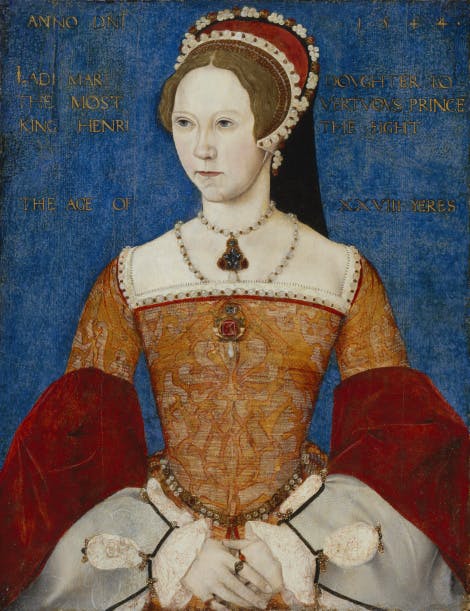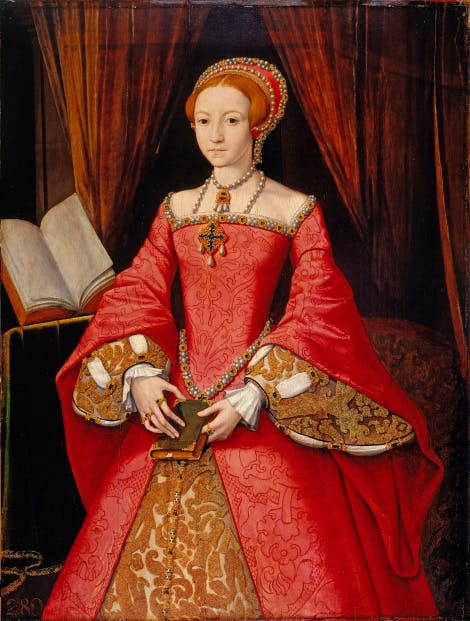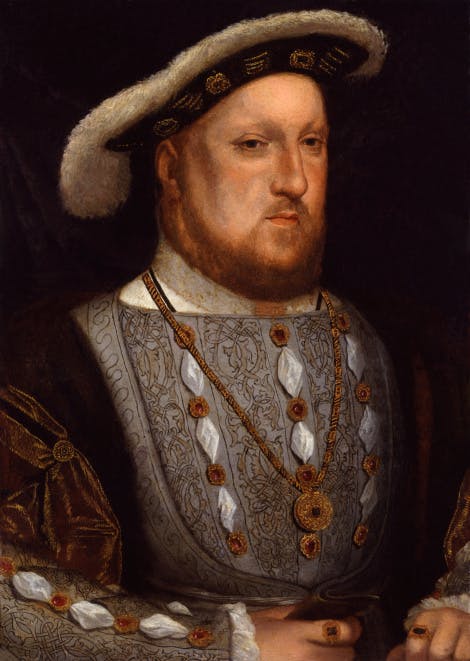
Edward VI, Mary I and Elizabeth I
The Magic Garden is closed 02 January 2026 due to adverse weather conditions.
Who succeeded Henry VIII?
All three of Henry VIII's legitimate children – Mary, Elizabeth and Edward – became queens or kings of England. They ruled consecutively after Henry’s death as Edward VI (1547-53), Mary I (1553-58) and Elizabeth I (1558-1603).
Each played an important role in both British history and the history of the royal palaces. However, none of them had children themselves, and on Elizabeth’s death, the Tudor dynasty ended.
Henry VIII’s legitimate children
Mary, born in 1516, was the only surviving child of King Henry VIII’s 24-year marriage to Katherine of Aragon. Seventeen years later, Elizabeth was born to Henry and his second wife Anne Boleyn, in 1533.
Henry's third queen Jane Seymour gave him his long-awaited male heir, Edward, in 1537.
The King’s lost children
Henry Duke of Cornwall was the first-born son of Henry and his first wife Katherine of Aragon. He only survived for a few weeks in 1511. Aside from their daughter Mary, Katherine's many other pregnancies only resulted in still-births or miscarriages.
Henry and his second wife Anne Boleyn also lost two children before their term.
Header: Detail of The Family of King Henry VIII, Royal Collection Trust / © Her Majesty Queen Elizabeth II 2017
Henry VIII's illegitimate children
Henry also had an illegitimate son, named Henry Fitzroy (meaning 'son of the king') born in 1519. The King made Fitzroy Duke of Richmond, and ensured he was well provided for. Fitzroy enjoyed a 'prince’s life' until his premature death at 17, probably from tuberculosis.
Rumours circulated at the time about Henry fathering other illegitimate children. Henry and Catherine Carey were the children of Mary Boleyn, Anne’s sister who was Henry’s mistress in the early 1520s. Henry never acknowledged them as his own, and Mary’s husband, William Carey, was recognised as their father at the time. But Catherine’s birth, at least, coincided with the dates of Henry and Mary’s affair.
There are no proven descendants of Henry VIII alive today.

Image: The front façade view of The Great Gatehouse, on the West Front of Hampton Court Palace. © Historic Royal Palaces
Henry VIII's children at Hampton Court Palace
Edward was born and christened at Hampton Court Palace in 1537. Henry is said to have wept with joy as he held his infant son, then wept again a few days later when the Queen, Jane Seymour died from post-birth complications.
Mary married King Philip II of Spain, and the royal couple spent their honeymoon at Hampton Court in 1554. A year later, Mary believed she was pregnant and the court gathered at the palace to await the birth. But no baby ever came.
Elizabeth ordered the creation of a marvellous 'Paradise Chamber' at Hampton Court, decorated with precious metals and gems to impress visitors. The queen also had a new Privy Kitchen built – it's now the visitor café!

Image: Portrait of Edward VI after Hans Holbein the Younger c1542, © National Portrait Gallery, London
Edward VI, born 1537, reigned 1547-53
Henry VIII and Edward VI
While Henry had little direct contact with his son Edward, he worried about his health and established strict rules about hygiene in the royal nursery. Edward’s apartments were washed several times a day and his food tested by servants.
In 1538, when Henry did visit, he rejoiced in his ‘most precious jewel’ and ‘held him in a window to the sight and great comfort of all the people’.
Edward's childhood
When Edward was a little older, he studied under Protestant scholars, who instilled in the Prince a desire for religious reform, as well as fluency in Latin, Greek and French. For entertainment outside of lessons, Edward even had his own fighting bears.
Edward was close in age to his half-sister Elizabeth, and the two became close, while sharing a similar education, quite apart from their much elder sibling Mary, whose Catholicism remained devout throughout the last years of Henry VIII’s reign.
The 'rough wooing' of Mary Queen of Scots
Towards the end of his reign, Henry VIII tried to make peace with Scotland, with whom England had often been at war.
The Treaty of Greenwich recommended a union of the two countries and a marriage between Edward and the infant heir to the Scottish throne, Mary Queen of Scots. The treaty was rejected by the Scottish Parliament, and England invaded Scotland in an unsuccessful attempt to force the agreement.
Edward VI: the boy King
After Henry VIII’s death in 1547, his son was crowned Edward VI aged just nine years old. Coronation revels were held at Hampton Court where the young King acted in plays and masques, just like his father.
Edward’s uncle Edward Seymour, Duke of Somerset, acted as Edward’s governor and ‘Lord Protector’ of the realm. But by 1550, Seymour had been replaced in a palace coup led by John Dudley, Duke of Northumberland. Seymour even attempted to hold Edward hostage at Hampton Court in a bid to retain power.
Was Edward VI a good King?
Judging the actions of a teenaged boy under the direction of adult ministers with their own agenda is difficult. Certainly, Edward’s reign saw the foundations laid for one of the great transformations of English society, the English Reformation.
But there was also an expensive war with Scotland, economic crises and food shortages, which led to armed uprisings across the country. Edward's zeal for Protestant reform was also not universally supported, and the country remained divided.
Edward VI's death
Edward did not live to see the successful realisation of many of his religious plans. Falling ill in 1552, he finally succumbed in 1553, aged only 15.
The country was once again plunged into uncertainty, as religious reformers and conservatives battled for control of the country.
Learn more about Edward VI
Image: Portrait of Queen Mary I by Master John, 1544, © National Portrait Gallery, London
Mary I, born 1516, reigned 1553-58
Henry VIII and Mary I
Mary was, for many years, Henry’s only legitimate child. Born at Greenwich Palace in 1516, she was given her own household and a scholarly education partly directed by her staunchly Catholic mother, Katherine of Aragon.
When Henry annulled his marriage with Katherine, Mary’s royal future looked doubtful: she was demoted from 'princess' to the status of 'lady', lost her place in the line of succession and banned from seeing her mother. Her relationship with her father never properly recovered.
Mary’s personality and faith
Mary never fully accepted her father's break with the Catholic Church, a sign of her devout faith and her resolute determination to undo the English Reformation.
When her younger half-brother became King, Mary became a focus for opposition to Edward’s Protestant policies.
Mary I’s reign and marriage
Because of Mary’s Catholicism, Edward, facing death in 1553, sought to thwart his half-sister’s claim to the throne. His Protestant ministers aimed to crown Edward’s cousin, Lady Jane Grey, in her place. But Mary’s supporters proved more powerful, and Jane’s 'reign' lasted only nine days.
Aged 37 on her accession, the new Mary I moved swiftly to secure her own dynasty. She married Philip II of Spain in 1554, as a way of gaining continental support and, hopefully, an heir. But Mary also ensured that Parliament recognised her right to rule as a woman, with the same powers as a king.
Was Mary a good Queen?
Mary I was the first female monarch to rule England unopposed and in her own right, and she successfully faced down opposition, defeating the Wyatt rebellion of 1554. Prejudice against Mary and her religion, during her reign and since, has obscured a more balanced assessment of her achievements.
As Queen, Mary proved conscientious and practical, championing economic and trade policies aimed at solving complex problems left by her father and brother; Mary’s ministers initiated reforms that would have a lasting impact.
Mary’s passionate determination to restore Catholicism as England’s official state religion led to opposition, rebellion and oppression. Her government’s ruthless pursuit of 'heretics' resulted in public executions of nearly 300 Protestants.
Mary was not the only Tudor monarch to promote religious persecution, torture and execution as an instrument of state control. But her early death left her Protestant enemies in control of her legacy; they were all too happy to paint a picture of her as a blood-soaked tyrant.
Mary I's death
In January 1558, England lost Calais, her last area of land on European soil, to the armies of France. By the end of the year, aged 42, Mary was dead, probably from the cancer that had earlier falsely led her to believe that she was pregnant.
Learn more about Mary I
Image: Portrait of Princess Elizabeth, c.1546. Attributed to William Scrots (active 1537-53), Royal Collection Trust / © Her Majesty Queen Elizabeth II 2017
Elizabeth I, born 1533, reigned 1558-1603
Henry VIII and Elizabeth I
Elizabeth’s happy infancy was shared with her younger half-brother Edward in the royal nursery. But when her mother, Anne Boleyn, was executed in 1536, charged with adultery and treason, the future of the two-year-old Princess was thrown into doubt. Like her elder half-sister Mary, Elizabeth was declared illegitimate and lost her royal status.
By the time of Henry VIII’s last marriage to Katherine Parr, all three of Henry’s children were back at court. Katherine took an interest in Elizabeth’s education, passing on her ideas for Protestant reform, while setting an example of mindful and prudent queenship.
Elizabeth I and her siblings
As a teenager during her half-brother Edward VI’s reign, Elizabeth was courted by Thomas Seymour, the brother of the Lord Protector, as he sought to lever himself into a position of power. Seymour's actions were considered treasonable and he was executed in 1549. Elizabeth’s relationship with Edward deteriorated as a result.
After Edward’s death, Elizabeth’s sympathies with religious reformers meant she became the focus for opposition during the reign of her sister, Mary I. At one point, Mary imprisoned Elizabeth in the Tower of London, and she was also held under house arrest at Hampton Court.
Elizabeth I's personality
Elizabeth’s experiences during the reigns of Edward VI and Mary I taught her to be evasive, level-headed, cautious and shrewd.
These qualities proved to be useful attributes for her own reign. When she became Elizabeth I in 1558 aged 25, she navigated a court and a country still divided by faith. Her 'Elizabethan Settlement' tried to find a compromise between Catholics and Protestants, and helped establish the Church of England as the nation's long-lasting state religion.
The Elizabethan golden age?
Looking back, Elizabeth I's 44-year reign is often championed as a golden age of English literature, music and drama, the age of William Shakespeare. English adventurers like Walter Raleigh and Francis Drake set off on great voyages of discovery, circumnavigating the globe and establishing colonies and trading outposts in America, Africa and Asia.
Yet at the same time, religious persecution continued under Elizabeth I, as well as an expensive war with Spain. The end of her reign brought high taxes, economic hardship and discontent.
Elizabeth I's death
Elizabeth I never felt truly secure. She survived smallpox in 1562, as well as plots against her life throughout her reign. She died, after a short illness, at Richmond Palace in 1603, aged 69 years old.
Elizabeth was buried in Westminster Abbey, initially in the vault of her grandfather Henry VII. In 1606, the new King, James I, erected a monument to Elizabeth in the Abbey, and the Queen was reinterred beneath, in a vault shared with her half-sister Mary I.
Learn more about Elizabeth IThe end of the Tudor dynasty
Despite attempting, early in her reign, to secure a marriage, Elizabeth I didn't marry, much to the concern of her ministers. Instead, she doted on her 'favourites', ambitious courtiers like Robert Dudley, Earl of Leicester.
At the same time, Elizabeth established a successful image and legacy as 'The Virgin Queen', married and devoted to England.
At her death, the Tudor dynasty died with the Queen, and the crown passed to Elizabeth's closest relation, James VI of Scotland.
Discover more about Henry VIII

Henry VIII's lost gardens at Hampton Court
Discover a vast, glittering complex of lost Tudor buildings
Browse more history and stories

Henry VIII, Terrible Tudor?
Who was the real Henry VIII?

The Field of Cloth of Gold
Henry VIII's historic meeting with his great rival François I in 1520 was a defining point in his reign

The Elizabethan era: a golden age?
Was the Elizabethan period really a 'golden era' of English history?
Explore what's on

- Families
- Half term
- Things to see
February Half Term
Join a royal quest this half term with Elizabeth I at Hampton Court Palace.
-
14 – 22 February 2026
- 10:00-16:00
- Hampton Court Palace
- Included in palace admission (Members go free)

- Things to see
Hampton Court Gardens
Take time to explore and relax in these world-renowned gardens and find our free entry Garden Open Days dates.
- Open
- In line with palace opening hours
- Hampton Court Palace
- Included in palace admission (Members go free)

- Things to see
Pond Gardens
Discover the sunken gardens created for Henry VIII and transformed by Mary II.
-
Open
- In line with palace opening hours
- Hampton Court Palace
- Included in palace admission (Members go free)
Shop online

Christmas homepage banner - Henry VIII and Six Queens Decoration Set
Christmas Homepage Banner - Henry VIII and Six Queens hanging decoration set on a Christmas tree at Hampton Court Palace.
£70.00

Shop Tudors
Find the perfect gift for collectors and history enthusiasts in our treasure trove of souvenirs inspired by this ever-fascinating dynasty.
From £3.00

Shop Goblets & Tankards
Discover our decadent range of goblets and tankards inspired by the palaces in our care, the perfect gift for any history fan.
From £10.00
